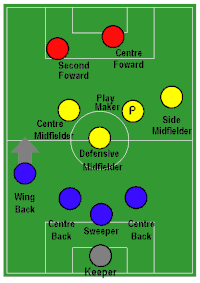Catenaccio
Catenaccio [ katɛnattʃo ] (from ital . Catenaccio "door bolt") is a game system in football .
This system was made famous by the Argentine trainer Helenio Herrera , who used the catenaccio with outstanding success at Inter Milan . The Milanese won three Italian championship titles under Herrera's leadership , twice the European Cup and once the World Cup . However, the origin of this style of play is the Swiss bar . The inventor of this game system, which emerged in the 1930s, was the Austrian Karl Rappan . He successfully practiced the system with the Swiss national team and the Grasshopper Club Zurich .
When catenaccio play in defense one Libero , two Vorstopper and a left -back , in midfield a defensive midfielder, two central midfielders and a right wing midfielders and storm a hanging top and a box striker. By standing deep in your own half, the spaces between the individual players should be made so narrow that the opponent cannot play a fast offensive game. On the other hand, the Catenaccio offers the possibility of quick counterattack: The opposing team is forced by their advancement to open spaces in their own defense, into which the players of the team playing with Catenaccio can advance in order to achieve a goal by quickly bridging the midfield come. In the case of counterattacks, defenders also take part in the offensive game. Giacinto Facchetti is considered to be the first modern offensive defender.
As a game system, the catenaccio went out of fashion in the 1970s and subsequently became synonymous with defensive and destructive football.
Web links
- Catenaccio on spielverlagerung.de
- Tactical revolutions: Rappan, Herrera and the Catenaccio
- Catenaccio - the dark side of football
- How the “Swiss Bar” revolutionized football
